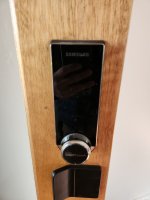Not a "sexy" industry to most I suspect but absolutely a necessary one these days.
A slice of this would be pretty satisfying.
Positive couple of mentions re neuromorphic and SNN.
Business
Smart Lock Market size worth $ 7.13 Billion, Globally, by 2030 at 13.71% CAGR: Verified Market Research®
24 August 2022 at 9:15 pm AWST
Smart Lock Market size worth $ 7.13 Billion, Globally, by 2030 at 13.71% CAGR:
Verified Market Research®
PR Newswire
JERSEY CITY, N.J., Aug. 24, 2022
The market for smart locks has been driven by the rising security and safety
concerns relating to preventing invasion, unauthorized access, theft,
burglary, and expanded functionality compared to standard locks.
JERSEY CITY, N.J., Aug. 24, 2022 Verified Market Research recently published a
report, " Smart Lock Market " By Type (Deadbolts, Lever Handles, Padlocks, and
Others), By Communication Protocol (Bluetooth, Wi-Fi, and Others), By Vertical
(Commercial, Residential, Institution & Government, Industrial, and Others),
and By Geography. According to Verified Market Research, the Smart Lock Market
size was valued at USD 2.55 Billion in 2021 and is projected to reach USD 7.13
Billion by 2030, growing at a CAGR of 13.71% from 2022 to 2030.
Global Smart Lock Market Overview
The increasing need for high performance Integrated Circuits is a major factor
in the growth of the global smart lock market.
By processing and storing data
on the same chip, neuromorphic devices can significantly cut down on the
amount of time a typical CPU spends moving data around. The time a regular CPU would have needed to shuttle data between a block of memory and the processor handling these memories' processing tasks is significantly decreased by the ability to combine processing and storage.
So, the demand for higher performing ICs is assisting the market's growth in the pursuit of efficient computing.
In order to increase productivity and product quality, a wide range of sectors
needs to automate their processes with the use of artificial intelligence and
machine learning. Numerous businesses, including those in the medical, media,
telecom, auto, food, and beverage sectors, use AI extensively.
Because SNN can make flexible and agile decisions while taking the situation's context into account as well as past experiences, it can effectively address the difficulties that these industries frequently face. Combining AI with ML can improve the efficiency of applications including fraud detection, credit scoring, speech recognition, self-driving cars, image classification, and language translation. The market is expanding as a result of an increase in demand for general-purpose cognitive and brain robots.
Key Developments
* February 2022 – Dormakaba finalised the acquisition of AtiQx Holding B.V.
in the Netherlands, bolstering its core business and services activities.
In the relevant market, AtiQx is one of the leading providers of
electronic access control and labour management.
* January 2022 – Vivint and New American Funding, one of the largest
independent mortgage providers in the country, have launched a strategic
alliance to help homeowners and purchasers protect their dream homes.
Customers of New American Funding will be eligible for special incentives
from Vivint to safeguard and automate their homes as a result of the
relationship.
Key Players
The major players in the market are Assa Abloy AB, Dorma+Kaba Holding AG,
Spectrum Brands Holdings, Inc., Allegion Plc, Onity, Inc.
Verified Market Research has segmented the Global Smart Lock Market On the
basis of Type, Communication Protocol, Vertical, and Geography.
* Smart Lock Market, By Type
* Deadbolts
* Lever Handles
* Padlocks
* Others
* Smart Lock Market, By Communication Protocol
* Bluetooth
* Wi-Fi
* Others
* Smart Lock Market, By Vertical
* Commercial
* Residential
* Institution & Government
* Industrial
* Others
* Smart Lock Market, by Geography
* North America
* U.S
* Canada
* Mexico
* Europe
* Germany
* France
* U.K
* Rest of Europe
* Asia Pacific
* China
* Japan
* India
* Rest of Asia Pacific
* ROW
* Middle East & Africa
* Latin America




